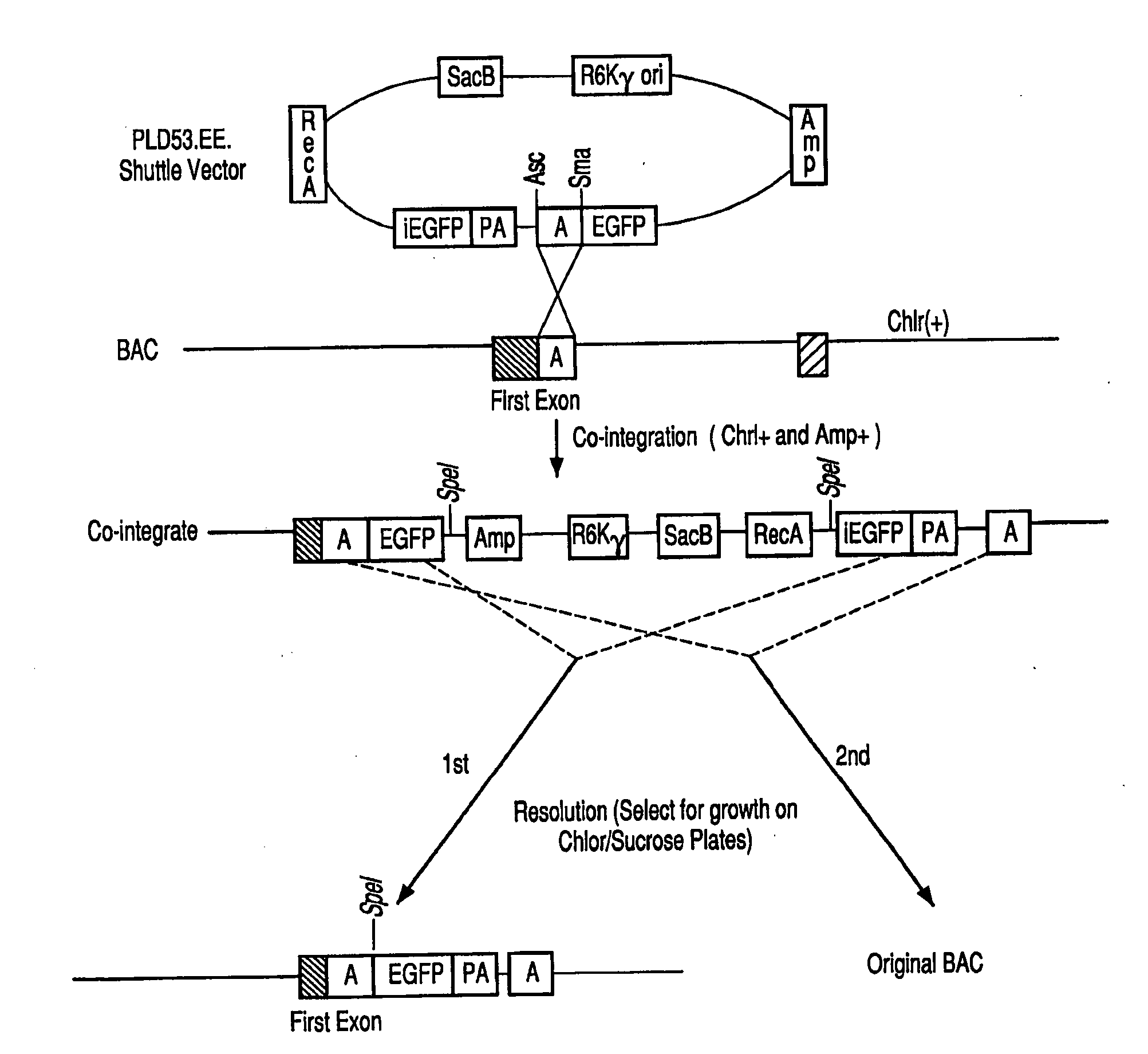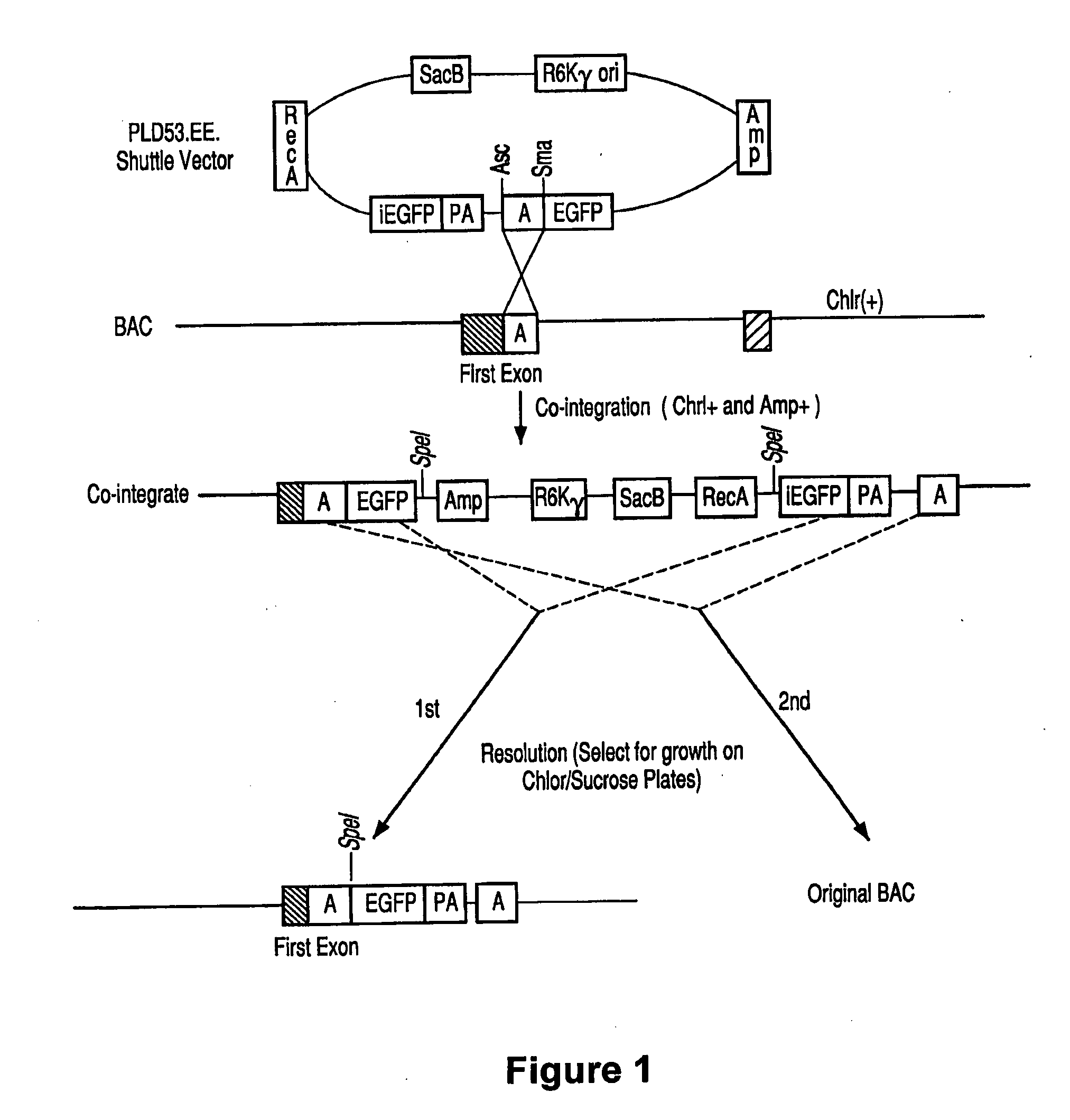Transgenic Mammals and Cell Lines for the Identification of Glutamate Transporter Modulators
a glutamate transporter and cell line technology, applied in the field of transgenic nonhuman mammals and cells, can solve the problems of increased functional activity, increased neuron loss, and increased risk of neuron loss, and achieve the effect of reducing the probability of developing a disorder
- Summary
- Abstract
- Description
- Claims
- Application Information
AI Technical Summary
Benefits of technology
Problems solved by technology
Method used
Image
Examples
example 1
Generation of BAC Transgenic Mice for GLAST and GLT-1
[0220] The BAC transgenic mice are useful for studying the biology of glutamate transport and generating cells for screening compounds capable of activating the GLAST and GLT-1 genes. The transgenic mice were generated carrying bacterial artificial chromosomes (BACs) containing the mouse GLAST or GLT-1 genes plus at least 40 kB of DNA upstream of the first exon, all of the introns, and at least 20 kb of DNA downstream of the final exon. In each case, eGFP cDNA has been placed within the initiating ATG codon so that when the promoter is activated, fluorescent protein is produced. Mouse BACs RPCI-24-287G1 1 and RPCI-23-361H22, both obtained from BAC-PAC Resources (Oakland, Calif.; clones may also be referred to as RP24-287G11 and RP23-361H22, respectively), were used for the GLAST and GLT-1 reporter mice, respectively. The GLAST BAC sequence is on mouse chromosome 15; the GLAST is gene slcla3 on mouse chromosome 15 at locus positio...
example 2
GLAST and GLT-1 Promoters are Activated in Different Brain Regions at Postnatal Days 1 and 24 (Double Transgenic)
[0240] Past immunochemistry demonstrated that astrocytes may express both GLAST and GLT-1. To investigate the cellular expression patterns of GLT-1 and GLAST, GLAST-DsRed and GLT-1-eGFP BAC transgenic mice were crossed to create double transgenic mice. These double transgenic mice were used for identification of cells capable of both GLAST and GLT-1 expression. These double transgenic mice offered the opportunity to view GLT-1 and GLAST promoter activation levels in parallel. Grossly, at both low power and even higher power microscopy, there were few examples of overlap between GLAST and GLT-1 expression. Images from specific brains regions at PND's 1 and 24 are shown in FIG. 6. In cerebellum (FIG. 6A and FIG. 6B), GLAST promoter activation was observed in the external granule layer at PND 1 and primarily in the Bergmann glia by PND 24, whereas the GLT-1 promoter was con...
example 3
GLAST and GLT-1 Promoters are Active in Distinct Subsets of Cells
[0243] In order to explore the cell types demonstrating both overlapping and non-overlaping overlaping activation of GLAST and GLT-1 promoters, GFAP marker to identify astroctyes were added to the confocal images of several regions at PND 24. Some of these studies were performed on tissues obtained from double transgenic animals expressing both the GLAST-DSRed promoter reporter and the GLT1-eGFP promoter reporter. As shown in FIG. 7A, both GLAST and GLT-1 promoters were active in GFAP positive astrocytes of the hippocampus dentate gyrus (yellow arrows), as well as in the radial glia, but there were also cells in the granule cell layer (gcl) in which the GLAST promoter was active independent of the GLT-1 promoter or GFAP protein (white arrows). In a higher magnification view of cells in the hippocampus CA3 region, shown in FIG. 7B, it was apparent that GFAP positive astrocytes demonstrated GLAST and GLT-1 promoter acti...
PUM
| Property | Measurement | Unit |
|---|---|---|
| Density | aaaaa | aaaaa |
| Fluorescence | aaaaa | aaaaa |
Abstract
Description
Claims
Application Information
 Login to View More
Login to View More - R&D
- Intellectual Property
- Life Sciences
- Materials
- Tech Scout
- Unparalleled Data Quality
- Higher Quality Content
- 60% Fewer Hallucinations
Browse by: Latest US Patents, China's latest patents, Technical Efficacy Thesaurus, Application Domain, Technology Topic, Popular Technical Reports.
© 2025 PatSnap. All rights reserved.Legal|Privacy policy|Modern Slavery Act Transparency Statement|Sitemap|About US| Contact US: help@patsnap.com



